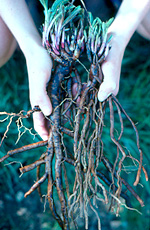Echinacea
Echinacea purpurea
family:Asteraceae

the plant: Upright flowering taprooted perennial with long stem and dark green lance-shaped leaves, grows up to four feet high, spreads up to 1.5 feet wide. Large daisy-like cerise flower with a prickly domed brown center, petals 1+ inch long. Prefers good, moist garden to sandy soil & plenty of sun. Native to North America.
parts used: root.
medicinal actions: antimicrobial, immunoregulator, lymphatic, anti-inflammatory, anticatarrhal, vulnerary, carminative, stimulant, alterative, tonic, antifungal.
indications (apply to all species): This cooling, spicy/acrid-tasting root is the famous 'i feel like i'm getting sick'  remedy. Echinacea can chase off or help speed recovery from an acute bacterial or viral infection, especially infections of the upper respiratory tract. As a stimulant for the immune system, it is best taken frequently at earliest onset of acute symptoms or if at particular risk of infection, but not as a daily immune tonic. It is indicated specifically for septic infections and rotting tissue. Used by the Plains Indians for a great range of medicinal purposes both topically and internally, echinacea also has antiseptic and anti-inflammatory qualities useful for application to wounds, burns, fungus or boils. Can also be useful with allergic reactions or venomous bites, or as a digestive stimulant. A cooling herb, it is best combined with warming herbs in a formula.
remedy. Echinacea can chase off or help speed recovery from an acute bacterial or viral infection, especially infections of the upper respiratory tract. As a stimulant for the immune system, it is best taken frequently at earliest onset of acute symptoms or if at particular risk of infection, but not as a daily immune tonic. It is indicated specifically for septic infections and rotting tissue. Used by the Plains Indians for a great range of medicinal purposes both topically and internally, echinacea also has antiseptic and anti-inflammatory qualities useful for application to wounds, burns, fungus or boils. Can also be useful with allergic reactions or venomous bites, or as a digestive stimulant. A cooling herb, it is best combined with warming herbs in a formula.
contraindications: Nothing known. very safe. could in theory interact with immunomodulator drugs.
preparation: boiled root tea; tincture, glycerite; chewing the root (traditional Native).
note: This information is not a replacement for a trained herbalist. Please consult your medical professional before treating yourself or others with this or any other herbal remedy.